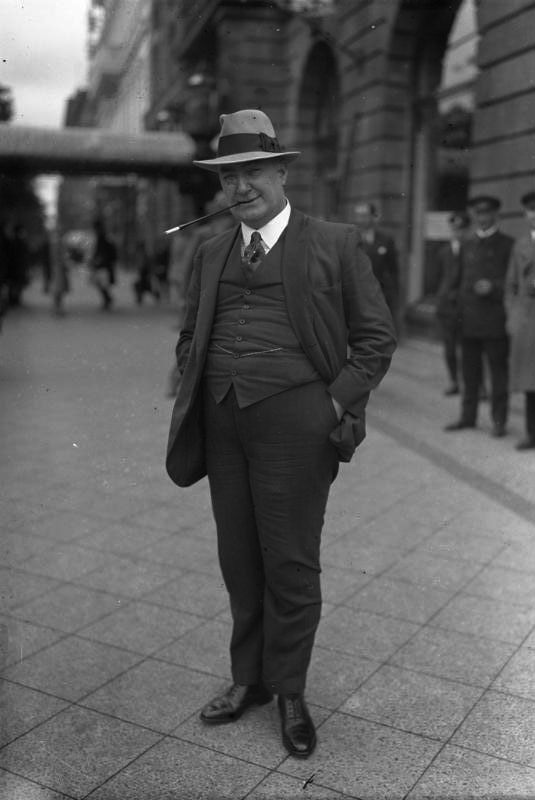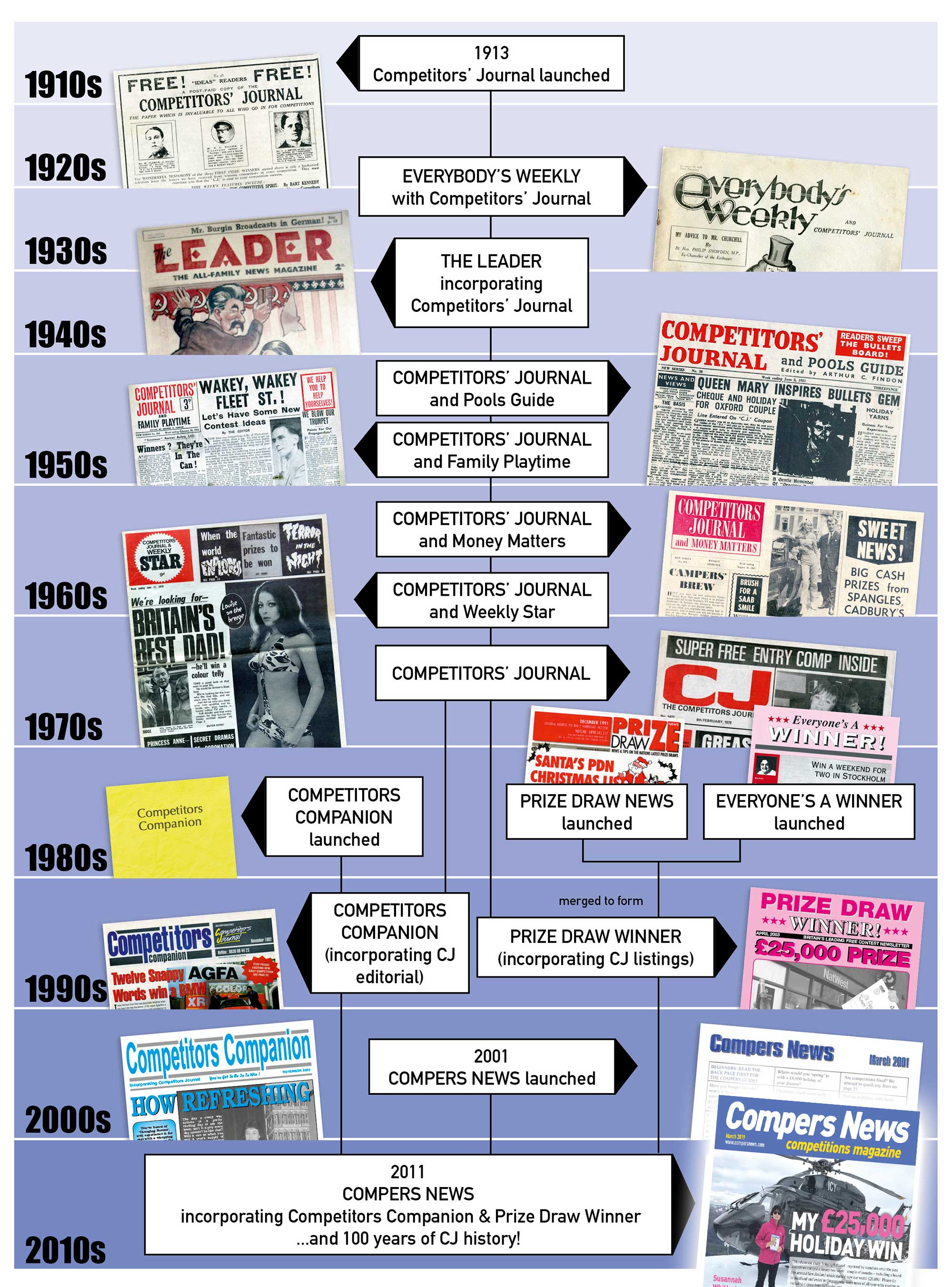
Britain’s first comping newspaper went on sale over 100 years ago, and Compers News is proud to be part of that very first publication’s family tree. Editor Steve Middleton takes a look through the archive and uncovers a fascinating history…
1913: The Birth of Competitors’ Journal
Competitions started to become popular in the UK towards the end of the 19th century, and it wasn’t long before every newspaper and magazine worth its salt was giving away huge prizes. In those days, the law meant that every contest was skill-based and one of the most popular competitions of the era was John Bull magazine’s ‘Bullets’ phrase-making game which launched in 1912. When the famous author Edgar Wallace met with a journalist friend, Arthur Charles Findon, to discuss their weekly Bullets entries, they instead found themselves talking about an idea for a publication aimed at competitors. This would have news of all the main newspaper and magazine competitions together in one place, and would “advise, assist, encourage and inform” readers on the tasks and prizes on offer. Their weekly newspaper – Competitors’ Journal – launched in early 1913 and was an immediate success.
1920s: After the Great War
Arthur C. Findon left his editor’s post to serve in the Great War, and on his return from service he sold his interest in Competitors’ Journal to a publisher friend called Freddie Poke. Almost immediately, the format changed to that of a general interest magazine and the name also changed to ‘Everybody’s Weekly and Competitors’ Journal’ – with the ‘Competitors’ Journal’ part of the title becoming ever smaller with each passing week!

The Importance of the Small Print
As well as being a renowned crime writer, Edgar Wallace was a prolific comper who used his writing skills to try to win the weekly Bullets competition and other similar word games of the day. He was also a regular contributor to Competitors’ Journal when it launched.
Despite the vast earnings from his books, Wallace found it difficult to finance his lavish lifestyle and he turned to gambling and dubious get-rich-quick schemes. In 1905, before the launch of CJ, he persuaded the Daily Mail to run a promotion that he himself had conceived and which brought together his love of writing, comping and business opportunities. To tie-in with the publication of his latest book ‘Four Just Men’, he came up with a ‘guess the murder method’ competition. But Wallace made a serious error. He failed to include a clause in the competition rules restricting payment of the prize money to one winner only, and it was only after the competition had closed and the correct solution printed as part of his book that he realised he was legally obliged to pay every person who had answered correctly. Shock turned to horror as the number of correct entries continued to inexorably rise, and the owner of the Daily Mail was furious when he had to loan Wallace over £5,000 (around £2million today) to cover the prize fund and protect the newspaper’s reputation.
Luckily this didn’t put Edgar Wallace off comping though, and just a few years later he helped to launch Competitors’ Journal. The moral of the story then though remains just as true and important for compers today. Always read the small print!
1930s: Findon Returns
Another general interest magazine similar to Everybody’s Weekly was called The Leader, and in the early 1930s Arthur C. Findon took over as editor of this rival magazine and sent its circulation soaring. And the reason for this success? Well, Arthur couldn’t quite forget his interest in comping and introduced a section at the back of The Leader based on his original Competitors’ Journal concept. The success of Bullets in particular had seen a huge number of similar competitions and crosswords spring up, and thousands of people were now buying The Leader for its expert guidance.
1940s: Competitors’ Journal Reborn
As yet another World War intervened and the fashion for general interest magazines began to wane, both Everybody’s Weekly and The Leader were eventually sold by their publishers and merged into other titles. Which left Arthur C. Findon without a job and the Competitors’ Journal name without a home. There was only one thing for it, and by 1949 plans for a relaunch of CJ were already at an advanced stage.
1950s: The Golden Era
In 1950, Competitors’ Journal and Pools Guide hit the newsstands to huge acclaim. With the backing of the publisher of some of the biggest magazines of the time including True Romance, Photoplay and True Detective, the future of the paper seemed assured. The format of the relaunched title remained almost unchanged to what had gone before: advice on competitions from most of the newspapers and magazines of the day. Because these competitions had a small entry fee, the publications in which they originally appeared soon realised that by reproducing the entry forms in CJ they’d receive thousands more paid entries, so before long the paper was packed with official entry forms and advice. A typical issue would include crosswords from John Bull magazine, the Sunday Chronicle, The People and News of the World, plus a wide selection of spot-the-ball, order-of-merit and word games from other sources. By buying CJ each week, readers would get 10 or more entry forms all in one place along with proven winning advice, and by now the paper’s circulation exceeded 100,000 copies per week.
This would prove to be the Golden Era for Competitors’ Journal. Following the death of Arthur C. Findon in 1957, Aubrey Morris became editor but things would never be the same again. Newspapers and magazines that had advertised their competitions in CJ slowly began to fold and merge, and as the number of entry forms included in the paper began to dwindle, so did the readership. By 1959, circulation was down to 70,000 and CJ’s publisher announced that the title would fold.
1960s: What’s in a Name?
In an attempt to save the title from closure, editor Aubrey Morris scraped together enough money to buy CJ from its then publisher and set about retaining the 70,000 readers who were still on board. But then disaster struck. Less than a month after buying the title, John Bull magazine decided to discontinue their iconic Bullets contest after almost 50 years. The effect on CJ’s circulation was catastrophic, and it plunged to just 30,000 almost overnight. Little did anyone realise that so many people bought CJ simply because of its unrivalled Bullets advice and success rate.
In an attempt to steady the ship, CJ launched its own version of Bullets – called Quads – and the editor started to woo promoters of the newly popular on-pack and entry form competitions that had started to appear in grocery stores and the new self-service ‘supermarkets’ that were springing up on the high street. The full title of the paper by now was ‘Competitors’ Journal and Family Playtime’, and more general comping advice and listings started to appear.
Within a few short months, only one newspaper still ran an ad in CJ – the News of the World. At the same time, CJ’s editor was hearing rumours that the News of the World was looking to launch a popular financial paper along the lines of the Daily Mail’s Money Mail supplement. So he approached the News of the World with a proposal, and by 1962 they were the owners of CJ. The first issue of ‘Competitors’ Journal and Money Matters’ launched almost immediately, and alongside advertisements for banks and insurance companies, you’d find entry forms for all the biggest consumer competitions of the day. In one issue alone, Heinz were giving away 57 cars, and Hoover and Osram a brand new house each. It didn’t take too long for circulation to start climbing again.
The News of the World’s magazine arm began to expand, and pretty soon CJ’s stablemates included such unlikely bedfellows as Boxing News, TV21 comic and Men Only! CJ’s reputation was also at its height amongst promoters and handling houses, and “winners names will be published in Competitors’ Journal” became a regular clause in standard T&Cs of the time.
1970s: The March of Murdoch
In late 1969, the News of the World – along with The Sun – was bought by Rupert Murdoch. For a time, the magazine side of the business – including CJ – seemed forgotten as the new proprietor concentrated on his newspapers. But in the early 1970s, all of that was about to change in spectacular style. Murdoch’s interests in the USA included a hugely successful shock-tabloid newspaper called The Star, similar to titles like Reveille and Titbits then on sale in this country. On reviewing the ‘dull’ CJ, he decided that it could do with livening up a bit, and decided to launch a UK version of The Star on the back of CJ! So, the title changed yet again – this time to ‘Competitors’ Journal: The Star Weekly’ – on its way to becoming ‘Competitors’ Journal and Weekly Star’. The new title was a disaster, and the CJ name was restored after just a few months. Soon after this, Rupert Murdoch lost interest in his UK magazine business and all the titles were sold off. CJ found itself in the hands of a small publisher which also became involved in the then brand-new genre of monthly puzzle magazines. Things became a lot calmer, and CJ could look forward to several years of stability – albeit with a much lower profile and circulation than before.
This WAS the 70s though, and even CJ couldn’t escape the attitudes of the era. Previously serious ‘order of merit’ photo comps became an excuse for many newspapers and magazines to show pretty girls in various states of undress, and ‘Meet Our Gorgeous Readers’ became a regular weekly feature in CJ! “Are you a gorgeous reader? Send us your picture and win £2 if we use it!” Which all sounds a bit more exciting than our current Winners Gallery, I suppose…
1980s: Fortnightly Fun
As circulation continued to decline, the paper found itself in a vicious circle of falling sales and rising costs, and the number of pages was down to just 12 a week. So by 1980, the decision had been taken to go fortnightly and to adopt a magazine-style size and format. Just one year later, CJ found itself with a serious rival for possibly the first time ever. Competitor’s Companion was launched in 1981 with a huge amount of publicity and a massive marketing budget. Following the success of CC, its publisher followed with Prize Draw News a couple of years later. The comping magazine marketplace was becoming very crowded indeed!
1990s: A Time for Consolidation
As the publishers of Competitor’s Companion and Prize Draw News spent a huge amount of money convincing people of the merits of comping, other publishers began to try their luck in the market – with varying degrees of success. Before long, compers were spoilt for choice – but it was a choice that couldn’t be sustained. Prize Draw News merged with Everyone’s a Winner to become Prize Draw Winner, and at around the same time the publishers of CC and PDW acquired Competitors’ Journal. Despite relaunching the magazine in full colour, CJ simply couldn’t compete with the circulation figures of its stablemates and so the decision was taken in early 1992 to change the frequency of CJ to a monthly publication.
The major downside of this change was the loss of CJ’s renowned football pools service. Longer publishing deadlines meant that forecasts could no longer be included in the magazine, and suddenly one of the most accurate and respected pools services in the UK was no more. Much like the loss of Bullets in the 1960s, no-one could have guessed how many readers subscribed to CJ simply for the pools advice – and once again the magazine’s circulation saw a sharp downturn almost overnight. This time, there would be no recovery. Competitors’ Journal was merged with both Competitor’s Companion and Prize Draw Winner over several months beginning in late 1992. The remaining editorial features would find a home in the pages of CC, while the main listings format was adopted by PDW. Although the most famous title in the history of comping magazines was no more, its legacy would live on in the pages of CC and PDW.
2000s: Introducing Compers News
Although they were still the two biggest comping magazines on the market, several changes of ownership had seen Competitor’s Companion and Prize Draw Winner lose some of their edge by the turn of the century. They failed to adapt when new comping trends and technologies came along, and new interactive comping services and forums began to appear on the then-fledgling internet. One of the earliest of these new services was the Chatterbox comping discussion forum, and it was so successful that a monthly magazine was launched in early 2001 to complement the service. That magazine was Compers News, and it was an instant success.
A couple of years later, Accolade Publishing acquired Competitor’s Companion and Prize Draw Winner and set about returning them to their former glories. In 2005, Compers News became part of the Accolade portfolio meaning that the UK’s biggest comping magazines and online services were now together in one place.

2010s: Altogether Now…
Before long, comping trends were shifting again and the lines between the different types of consumer competitions and prize draws were becoming increasingly blurred. Compers News, CC and PDW had until now each specialised in particular genres of comp (Prize Draw Winner on free prize draws, for example, Competitor’s Companion on skill and purchase-necessary comps, with Compers News taking a more CJ-style ‘pro-comper’ approach to the comping scene generally), but as it became more difficult to categorise comps along traditional lines, the magazines began to duplicate content. The decision was therefore taken in early 2011 to merge Competitor’s Companion, Prize Draw Winner and Compers News into a single monthly magazine to deliver a complete, consolidated comping service. History had come full circle, and once again UK compers would have a single comping title where they could find news, listings and advice together in one place.
2013: Going Forward
When Arthur C. Findon and Edgar Wallace launched Competitors’ Journal exactly one hundred years ago, they could never have imagined how “the hobby of entering competitions” – as they described it in their first issue – would evolve over the following century. Smartphones and computers really were just the stuff of outlandish science fiction back then, but the fact that there’s still demand for a comping magazine with a similar content mix to that very first edition proves the strength and longevity of their original vision. Who knows what the future holds? With the speed that technology is changing these days, we can’t even begin to guess what comping has in store – even in the next 2 or 3 years, let alone the next 100! One thing is for sure though… Compers News will hopefully be around for a good few years yet, carrying on the proud tradition of our forerunner. Here’s to the next 100 years!

Compers News' heritage stretches back over 100 years. Benefit from our experience and join us today.


Final comment
It was fascinating going through our archive to research this article, and I’d like to acknowledge former editors and contributors where original content, cuttings and photographs have been reproduced. Special thanks go to former CJ editor Aubrey Morris, whose ‘History of CJ’ article that appeared in the paper in 1979 proved invaluable in assisting my own research.